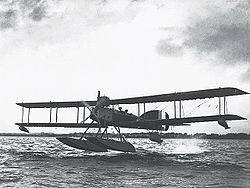Short 184
| Short Admiralty Type 827 | |
|---|---|
 Short 184 at launch Short 184 at launch
|
|
| Type: | Torpedo bombers |
| Design country: | |
| Manufacturer: | |
| First flight: |
1915 |
| Commissioning: |
1915 |
| Number of pieces: |
936 |
The Short Admiralty Type 184 was a British torpedo bomber in World War I . It was the first aircraft to sink a ship with a torpedo .
When the first British torpedo attempts were made shortly before the First World War, the British Admiralty urgently looked for a new aircraft for it. Horace Short then built the first two prototypes for the future Short 184 in the spring of 1915. The machine carried the torpedo between the two swimmers.
War effort
Both prototypes were moved to the HMS Ben-my-Chree at the end of May 1915 . This earlier passenger ferry had been converted into a seaplane carrier. The ship was on its way to the Dardanelles off the Turkish coast. The aircraft were initially used by the Royal Naval Air Service for sea reconnaissance and then used in the Battle of Gallipoli .
On August 12, 1915, Flight Commander Charles Humphrey Kingsman Edmonds flew the first successful torpedo attack on a Turkish merchant ship. The 14-inch (356-mm) torpedo hit the ship and exploded. However, the ship had already been torpedoed by the submarine HMS E14 and ran aground. On August 19, Edmonds and Flight Lieutenant George Dacre carried out another successful attack on a 5000-ton Turkish ship.
The Short 184 was very difficult to fly. With a torpedo on board, it was necessary to start with half-empty tanks. The flight time was limited to 45 minutes.
On March 25, 1916, two Sopwith Baby and three Short 184 from HMS Vindex flew an attack on the airship port in Tondern . However, they did not find their exact destination; only two machines returned to the HMS Vindex.
In the Skagerrakschlacht at the end of May 1916, four Short 184s were used on the seaplane carrier HMS Engadine . Lieutenant Frederick S. Rutland and the observer G. S. Trewin flew reconnaissance flights.
The Short 184 was built in large numbers. More than 900 were made by the end of the war. Many aircraft manufacturers were used for the construction, besides Short for example Saunders and Westland. Different engines such as Sunbeam Maori , Sunbeam Gurkha , Renault or Rolls Royce Eagle were used.
Towards the end of the war, the machines were also used for submarine hunting. But they were soon too slow against the more modern German sea fighter aircraft and had to be withdrawn to the second row.
The Short 184 served with the Fleet Air Arm until 1922 after the war . A number of machines were sold abroad. The Estonian Air Force received six machines in 1919; the Chilean Air Force also received six machines. More machines went to Japan and Greece .
Museum plane
Fragments of a Short-184 fuselage are on display at the Fleet Air Arm Museum in Yeovilton , Somerset today . A complete copy hangs in the Seaplane Harbor Museum in Tallinn.
Technical specifications
| Parameter | Data |
|---|---|
| crew | 2 |
| length | 12.40 m |
| span | 19.40 m |
| height | 4.10 m |
| Wing area | 63.9 m² |
| Max. Takeoff mass | 2433 kg |
| drive | a V12 Sunbeam Maori engine with 260 hp (191 kW) |
| Top speed | 139 km / h |
| Range | 320 km |
| Service ceiling | 2743 m |
| Empty mass | 1680 kg |
| Armament | a 7.7 mm Lewis machine gun, a 14 inch (356 mm) torpedo, or 236 kg bombs |
See also
Web links
- Fleet Air Arm Archive Short 184
- Fuselage of a Short 184 in the Fleet Air Arm Museum in Yeovilton, Somerset
- RAF Museum British Military 1915 ( Memento of March 14, 2007 in the Internet Archive )
- Air Vice Marshal CHK Edmonds, Short 184, 1915
Individual evidence
- ↑ Lennusadam Seaplane Harbor. Accessed March 12, 2016 .